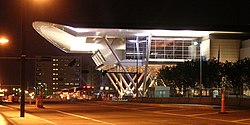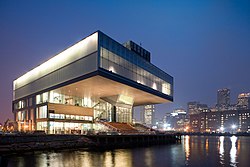


The Seaport District, or simply Seaport, is a neighborhood in Boston, Massachusetts. It is part of the larger neighborhood of South Boston, and is also sometimes called the Innovation District.[1] The Seaport is a formerly industrial area that has undergone an extensive redevelopment effort in recent years. It is bordered by the Fort Point Channel to the west, Boston Harbor to the north and east, and the historic residential neighborhood of South Boston to the south. It is officially referred to by the City of Boston as The South Boston Waterfront.[1] The Seaport District is at risk of climate-related flooding over the next 30 years.[2][3]
Name
[edit]The section of South Boston north of First Street was targeted for massive redevelopment by the administration of Mayor Thomas Menino and the Boston Planning and Development Agency.[4] Initially referred to as the Seaport District by the BRA, the area was officially restyled the "South Boston Waterfront" after virulent protest from natives and local politicians, including City Council President James M. Kelly.[5] Despite this, it is commonly known as the Seaport District.[6][7] The name Innovation District was also proposed.[8]
Development
[edit]Development in the Seaport has boomed during the early 21st century. It was considered "the hottest, fastest-growing real estate market in the country" in 2014.[9] As of 2017[update], it was the fastest growing part of Boston and has stimulated significant economic growth in the city.[10]
The restoration of the Seaport began with the completion of the Big Dig.[11] This $14.6 billion project buried the formerly elevated Central Artery I-93 Interstate which previously cut off the waterfront from the rest of the city. Additionally, Interstate 90 was extended eastward from I-93 through the Seaport and across the Boston Harbor to Logan International Airport and East Boston to connect the SPID with downtown Boston, revitalizing the area and prompting a surge of growth.
The end of the Big Dig also created a completely new transportation network for the area.[12] The Silver Line of the MBTA provides public transportation to the area (and runs along the new expressway connecting to the airport), while the Boston Harborwalk runs along the north side of the district. The Evelyn Moakley Bridge connects the Seaport to Downtown Boston.
In May 2010, Menino announced plans for the city to develop 1,000 acres on the South Boston Waterfront as an Innovation District.[8] Inspired by the success of the 22@ model, the mayor's vision was to redevelop the then-mostly abandoned Seaport District into a hub for Information Age jobs and a new frontier for cutting-edge industries such as clean tech, health care information technology and mobile media.[13] It is now home to tens of new office towers, residential buildings, and "innovation labs" either proposed or under construction.[14] The buildings are designed with critical systems above the first floor to avoid flooding from the tides.[15]
Between Menino's announcement of an innovation district in 2010 and 2017, 5,000 new jobs were created and over 200 new companies have formed.[10] Forty percent of the companies located in the Innovation District share space in co-working spaces and incubators.[10] Over 1,100 housing units were constructed, including 300 innovation micro-units.[10]
Commercial
[edit]As of 2017[update], the Seaport has 78 restaurants, 8 hotels, and continues to grow.[16] The South Boston Waterfront area is part of the Port of Boston on Boston Harbor.
In September 2010, the Seaport Square project was under planning. It was expected to cost $3 billion and replace parking lots between the federal courthouse and convention center with a 6,300,000-square-foot (590,000 m2) mixed-use development. Construction was expected to begin in 2011.[17]
In 2007, the Fallon Company was developing Boston's Fan Pier, one of the most sought-after waterfront sites in the United States, and a catalyst for the revitalization of South Boston's waterfront.[18] Fan Pier is a nine-acre, 21 city block site which consisted largely of underutilized parking lots when the Fallon Company purchased it for $115 million in 2005.[19] As of 2015[update], it was a neighborhood consisting of four commercial towers-–One Marina Park Drive, 11 Fan Pier Boulevard, 50 Northern Avenue, and 100 Northern Avenue—and a luxury condominium tower Twenty Two Liberty.[20][21] A second residential building, Fifty Liberty, was under construction at that time and to more high-rise towers were planned. When complete in 2020, the $4 billion Fan Pier project will encompass three million square feet of commercial and residential real estate, public, civic and cultural space, including two parks and a 6-acre marina.
On January 13, 2016, it was announced that GE would be moving its corporate headquarters from Fairfield, Connecticut, to the South Boston Waterfront. Some of the workers were planned to arrive in the summer of 2016 and the full move to be completed by 2018. GE ranks eighth on the Fortune 500 at the time and was to become the largest publicly traded company based in Massachusetts.[22][23] Subsequently, the company announced plans to shrink and eventually sold their property on Fort Point Channel for $287 million.[24]
In November 2016, the global athletic footwear and apparel company Reebok announced they would be moving their headquarters from the Boston suburb of Canton to the Innovation and Design Building in the Seaport District of South Boston. The reasons for the move, according to the company, is to be located in an urban environment that is more desirable to millennial workers and to "clarify the roles" of United States offices.[25] The move was completed in the fall of 2018.[26]
Soaring rent prices in the Seaport have raised concerns that the rapid real estate development in the area is pricing out entrepreneurs and startup companies – the organizations and people the Innovation District is designed to attract. In just a few years, rents have increased 43% in the Seaport, with the average rent at $52.92 per square foot, approximately at the same level of Boston's affluent Back Bay neighborhood.[27]
Residential
[edit]Due to the increase in nightlife in the neighborhood, on-street parking for residents has become increasingly scarce. In response, city officials launched a 90-day pilot program that will expand resident only parking to seven days a week, from four. The aim, according to City Council President Bill Linehan was to address the scarcity of parking for residents on weekends.[28]
According to The Boston Globe, a two-bedroom apartment in the Seaport area can rent for more than $5,000 per month and the purchase cost would be more than $2 million in 2018.[29]
Institutions
[edit]The Boston Convention and Exhibition Center straddles D Street. The convention center was built in 2004. The Seaport Hotel and Seaport World Trade Center is located on Commonwealth Pier. A new home for the Institute of Contemporary Art hangs over Boston Harbor just north of Northern Avenue.
The Society of Arts and Crafts, New England's oldest craft-focused nonprofit is situated closeby on Pier 4. The John Joseph Moakley United States Courthouse is on Fan Pier.[6]
The Seaport Shrine is right over the Moakley Bridge on Seaport Boulevard.[30]
Climate-related flood risks
[edit]A 2021 report by the First Street Foundation found that all critical infrastructure, nearly all commercial buildings, and 90% of roads in the Seaport District are at risk of becoming inoperable by mid-century due to climate-related flooding.[3]
References
[edit]- ^ a b "South Boston Climate Change Report" (PDF). Official Website of the City of Boston.
- ^ "The 3rd National Risk Assessment: Infrastructure on the Brink" (PDF). First Street Foundation. October 2021.
- ^ a b David, Abel (October 17, 2021). "Flooding could shut down Logan airport, hospitals, and other critical infrastructure in Mass., and the risk is only growing, report says". The Boston Globe.
- ^ "South Boston Waterfront Public Realm Plan". Boston Redevelopment Authority. October 21, 2003. Archived from the original on September 27, 2007. Retrieved 2009-02-01.
- ^ Marantz, Steve (June 12, 1999). "Menino ends name battle with S. Boston Waterfront". The Boston Herald.
But the major stipulation is the "South Boston Waterfront" name, a priority of City Council President James M. Kelly, who objected to the Seaport District appellation used in printed documents of the Boston Redevelopment Authority.
- ^ a b Vogel, Chris; and Patrick Doyle and Matthew Reed Baker (July 2012). "The Rise of the Seaport". Boston Magazine. Retrieved 26 March 2013.
{{cite news}}: CS1 maint: multiple names: authors list (link) - ^ Chesto, Jon (2012-04-17). "The South Boston waterfront gets a new website – and another new name". Mass. Market. Archived from the original on 27 May 2013. Retrieved 26 March 2013.
- ^ a b "Welcome innovationdistrict.org - BlueHost.com". www.innovationdistrict.org. Retrieved 4 July 2017.
- ^ Acitelli, Tom (11 June 2014). "On Southie Becoming South Boston". Curbed. Retrieved 18 June 2014.
- ^ a b c d "Welcome innovationdistrict.org - BlueHost.com". www.innovationdistrict.org. Retrieved 4 July 2017.
- ^ Katz, Bruce; Wagner, Julie. "The Rise of Innovation Districts: A New Geography of Innovation in America". Retrieved 14 December 2014.
- ^ James M. Kelly, long-time city councilor and South Boston icon, dies. Boston Globe, January 9, 2007.
- ^ "Welcome innovationdistrict.org - BlueHost.com". www.innovationdistrict.org. Retrieved 4 July 2017.
- ^ Various. "Seaport Square". Curbed. Retrieved 18 June 2014.
- ^ Pulver, Dinah Voyles; Fraser, Doug (January 18, 2021). 'The science is real': Coastal experts hope Biden will partner to combat sea level rise. Retrieved 2021-01-20.
{{cite book}}:|work=ignored (help) - ^ "Map Of Places - Boston's Seaport Neighborhood". Seaport. Retrieved 2017-10-04.
- ^ "Seaport makeover to begin next year". Boston Metro, 23 September 2010, p 3.
- ^ Cortese, Amy (October 7, 2007). "From Empty Lots to Bustling Waterfront". The New York Times.
- ^ C. Palmer Jr., Thomas (December 18, 2005). "The Dreamer". The Boston Globe Magazine. No. “Bostonian of the Year”.
- ^ Chesto, Jon (June 9, 2015). "With unusual sales plan, Fan Pier luxury units sell out". The Boston Globe.
- ^ Baskin, Kara (July 2015). "Views Included". Boston Magazine.
- ^ "Boston lands new GE headquarters". Boston Globe. Retrieved January 13, 2016.
- ^ Mann, Ted; Kamp, Jon (2016-01-13). "General Electric to Move Headquarters to Boston". The Wall Street Journal. Retrieved 2016-01-13.
- ^ Chesto, Jon (May 9, 2019). "GE selling Fort Point property for $252 million". The Boston Globe. Retrieved May 15, 2019.
- ^ Chesto, Jon (2016-11-03). "Reebok plans a big move — and some job cuts". Boston Globe. Retrieved 2016-11-04.
- ^ "Inside Reebok's new HQ in Boston's Seaport District". 18 July 2017.
- ^ "Rents soaring in city's Innovation District - The Boston Globe". The Boston Globe. Retrieved 4 July 2017.
- ^ Ryan, Andrew. "South Boston skeptical of parking changes". www.bostonglobe.com. The Boston Globe. Retrieved 11 August 2014.
- ^ Ryan, Andrew (2017-12-11). "A Brand New Boston Even Whiter Than The Old". The Boston Globe. Retrieved 2017-12-14.
- ^ Our Lady of Good Voyage. Archdiocese of Boston. p. 4. "This booklet has been published through the generous donation of John B. Hynes, III, Managing Partner at Boston Global Investors, in honor and memory of his grandfather, Mayor John B. Hynes, his father, Jack Hynes, and his mother, Marie Kelly Hynes. Mayor Hines was instrumental in founding the original Our Lady of Good Voyage in 1952. His son Jack hoped that this new Shrine would perpetuate the true mission of his Catholic faith to the thousands of new residents of Boston's emerging Seaport.".